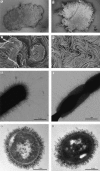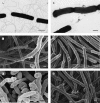Characterization of Bacillus anthracis-like bacteria isolated from wild great apes from Cote d'Ivoire and Cameroon
- PMID: 16855222
- PMCID: PMC1540047
- DOI: 10.1128/JB.00303-06
Characterization of Bacillus anthracis-like bacteria isolated from wild great apes from Cote d'Ivoire and Cameroon
Abstract
We present the microbiological and molecular characterization of bacteria isolated from four chimpanzees and one gorilla thought to have died of an anthrax-like disease in Côte d'Ivoire and Cameroon. These isolates differed significantly from classic Bacillus anthracis by the following criteria: motility, resistance to the gamma phage, and, for isolates from Cameroon, resistance to penicillin G. A capsule was expressed not only after induction by CO(2) and bicarbonate but also under normal growth conditions. Subcultivation resulted in beta-hemolytic activity and gamma phage susceptibility in some subclones, suggesting differences in gene regulation compared to classic B. anthracis. The isolates from Côte d'Ivoire and Cameroon showed slight differences in their biochemical characteristics and MICs of different antibiotics but were identical in all molecular features and sequences analyzed. PCR and Southern blot analyses confirmed the presence of both the toxin and the capsule plasmid, with sizes corresponding to the B. anthracis virulence plasmids pXO1 and pXO2. Protective antigen was expressed and secreted into the culture supernatant. The isolates possessed variants of the Ba813 marker and the SG-749 fragment differing from that of classic B. anthracis strains. Multilocus sequence typing revealed a close relationship of our atypical isolates with both classic B. anthracis strains and two uncommonly virulent Bacillus cereus and Bacillus thuringiensis isolates. We propose that the newly discovered atypical B. anthracis strains share a common ancestor with classic B. anthracis or that they emerged recently by transfer of the B. anthracis plasmids to a strain of the B. cereus group.
Figures





Similar articles
-
A new Bacillus anthracis found in wild chimpanzees and a gorilla from West and Central Africa.PLoS Pathog. 2006 Jan;2(1):e8. doi: 10.1371/journal.ppat.0020008. PLoS Pathog. 2006. PMID: 16738706 Free PMC article. No abstract available.
-
Capsules, toxins and AtxA as virulence factors of emerging Bacillus cereus biovar anthracis.PLoS Negl Trop Dis. 2015 Apr 1;9(4):e0003455. doi: 10.1371/journal.pntd.0003455. eCollection 2015 Apr. PLoS Negl Trop Dis. 2015. PMID: 25830379 Free PMC article.
-
Anthrax in Western and Central African great apes.Am J Primatol. 2006 Sep;68(9):928-33. doi: 10.1002/ajp.20298. Am J Primatol. 2006. PMID: 16900500
-
[Bacillus anthracis: a molecular look at a famous pathogen].Rev Argent Microbiol. 2011 Oct-Dec;43(4):294-310. doi: 10.1590/S0325-75412011000400010. Rev Argent Microbiol. 2011. PMID: 22274828 Review. Spanish.
-
What sets Bacillus anthracis apart from other Bacillus species?Annu Rev Microbiol. 2009;63:451-76. doi: 10.1146/annurev.micro.091208.073255. Annu Rev Microbiol. 2009. PMID: 19514852 Review.
Cited by
-
Draft Genome Sequence of Bacillus cereus LA2007, a Human-Pathogenic Isolate Harboring Anthrax-Like Plasmids.Genome Announc. 2017 Apr 20;5(16):e00181-17. doi: 10.1128/genomeA.00181-17. Genome Announc. 2017. PMID: 28428293 Free PMC article.
-
Assembly and Function of the Bacillus anthracis S-Layer.Annu Rev Microbiol. 2017 Sep 8;71:79-98. doi: 10.1146/annurev-micro-090816-093512. Annu Rev Microbiol. 2017. PMID: 28622090 Free PMC article. Review.
-
The Bacillus cereus Food Infection as Multifactorial Process.Toxins (Basel). 2020 Nov 5;12(11):701. doi: 10.3390/toxins12110701. Toxins (Basel). 2020. PMID: 33167492 Free PMC article. Review.
-
Bacillus cereus biovar anthracis causes inhalational anthrax-like disease in rabbits that is treatable with medical countermeasures.PLoS Negl Trop Dis. 2025 Apr 7;19(4):e0012973. doi: 10.1371/journal.pntd.0012973. eCollection 2025 Apr. PLoS Negl Trop Dis. 2025. PMID: 40193393 Free PMC article.
-
Antimicrobial Resistance Profile, Whole-Genome Sequencing and Core Genome Multilocus Sequence Typing of B. anthracis Isolates in Croatia from 2001 to 2022.Antibiotics (Basel). 2024 Jul 11;13(7):639. doi: 10.3390/antibiotics13070639. Antibiotics (Basel). 2024. PMID: 39061321 Free PMC article.
References
-
- Agaisse, H., M. Gominet, O. A. Økstad, N. Gilois, V. Sanchis, A. B. Kolstø, and D. Lereclus. 1999. PlcR is a pleiotropic regulator of extracellular virulence factor gene expression in Bacillus thuringiensis. Mol. Microbiol. 32:1043-1053. - PubMed
-
- Boesch, C., and H. Boesch-Achermann. 2000. The chimpanzees of the Taï Forest: behavioural ecology and evolution. Oxford University Press, Oxford, United Kingdom.
-
- Bradaric, N., and V. Punda-Polic. 1992. Cutaneous anthrax due to penicillin-resistant Bacillus anthracis transmitted by an insect bite. Lancet 340:306-307. - PubMed
Publication types
MeSH terms
Substances
LinkOut - more resources
Full Text Sources
Other Literature Sources
Medical
Molecular Biology Databases

